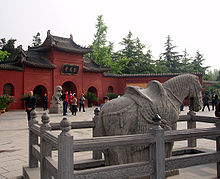Henan
Henan is home to many heritage sites, including Yinxu, the ruins of the final capital of the Shang dynasty (c. 1600 – c. 1050 BC) and the Shaolin Temple.With an area of 167,000 km2 (64,000 sq mi), Henan covers a large part of the fertile and densely populated North China Plain.[18] Widely regarded as one of the cradles of Chinese civilization along with the provinces of Shanxi and Shaanxi, Henan is known for its historical prosperity and periodic downturns.The Xia dynasty collapsed around the 16th century BC following the invasion of Shang, a neighboring vassal state centered around today's Shangqiu in eastern Henan.Although regarded formally as the ruler of China, the control that Zhou king in Luoyang exerted over the feudal kingdoms had virtually disappeared.He abolished the feudal system and centralized all powers, establishing the Qin dynasty and unifying the core of the Han Chinese homeland for the first time.The empire quickly collapsed after the death (210 BCE) of Ying Zheng and was replaced by the Han dynasty in 206 BC, with its capital at Chang'an.Luoyang quickly regained control of China, and the Eastern Han dynasty (25–220) began, extending the golden age for another two centuries.It collapsed due to Sui Emperor Yang's costly attempt to relocate the capital from Chang'an to Luoyang and the construction of many extravagant palaces there.[25] The succeeding Tang dynasty (618–907) kept its capital in Chang'an, marking the beginning of China's second golden age, with Henan being one of the wealthiest places in the empire.[27][28] But the Jurchen kept their main capital further north, until 1214, when they were forced to move the imperial court southwards to Kaifeng in order to flee the Mongol onslaught.Despite the rise of Zhengzhou, Henan's overall economy repeatedly stumbled as it was the hardest hit by the many disasters that struck China in its modern era.The PRC had earlier established a short-lived Pingyuan Province consisting of what is now northern Henan and western Shandong with Xinxiang as its capital.[34] In 1958, Yashan in Suiping County, Henan, became the first people's commune of China, heralding the beginning of the "Great Leap Forward".[35] In the subsequent famines of the early 1960s popularly attributed to the Great Leap Forward, Henan was one of the hardest hit and millions of people died.Suffering under famine and economic chaos caused by the Great Leap, locals in Henan offered low-level resistance mostly through banditry.[38] A destructive flooding of the Huai River in the summer of 1950 prompted large-scale construction of dams on its tributaries in central and southern Henan.[42] In 1978, however, when the communist leader Deng Xiaoping initiated the open door policy and embraced capitalism, China entered an economic boom that continues today.The Taihang Mountains intrude partially into Henan's northwestern borders from Shanxi, forming the eastern edge of Loess Plateau.The Nanyang Basin, separated from North China Plain by these mountains, is another important agricultural and population center, with culture and history distinct from the rest of Henan and closer to that of Hubei's.Excessive amount of sediments are formed due to the silt it picks up from the Loess Plateau, raising the river bed and causing frequent floods which shaped the habitat of the region.It has a distinct seasonal climate characterised by hot, humid summers due to the East Asian monsoon, and generally cool to cold, windy, dry winters that reflect the influence of the vast Siberian anticyclone.Subsequently, aborting fetuses due to their female sex was banned in Henan and heavy fines are issued for those who violate the law.Based on a 2009 British Medical Journal study, the ratio is over 140 boys for every 100 girls in the 1–4 age group;[63] this might be a strong exaggeration, as many families with more than one child do not register their daughters to the hukou in order to escape fines.Henan has planned its economy around the provincial capital of Zhengzhou, and it is hoped that the province may become an important transportation and manufacturing hub in the years to come.




Henan (disambiguation)河南 (disambiguation)ProvinceMount SongKaifengFawang TempleDengfengLongmen GrottoesNamed forYellow RiverZhengzhouprefecturescountiestownshipsParty SecretaryLiu NingLou YangshengGovernorWang KaiKong ChangshengNational People's CongressCentral Plains MandarinISO 3166 codeChinesePostalStandard MandarinHanyu PinyinBopomofoWade–GilesSuzhouneseYue: CantoneseYale RomanizationJyutpingSouthern MinTâi-lôCentral ChinaShang dynastyShaolin Templehistorical capitals of ChinaLuoyangAnyangNorth China PlainShaanxiShanxiShandongthird-most populous provinceworld's seventh-most populous17th-most populous in the worldVietnamoften sufferregional discrimination5th-largest provincial economySouth Central ChinaGuangdong18th-largest economyGDP per capitaheavy industryHigh-techXinxiangNature IndexYangshao CultureLongshan CultureNeolithic EraErlitou cultureXia dynastyvassal stateShangqiuYanshioracle bone scriptChinese writingZhou dynastyWestern ZhouSpring and Autumn periodConfuciusTaoismWarring States periodstate of QinYing Zhengfirst emperor of ChinaQin dynastyHan ChineseHan dynastygolden ageXin dynastyEastern Han dynastyXuchangCao CaoKingdom of WeiJin dynastyEastern HanChinese tomb muralDahuting Han tombsChinese culturesinificationSui dynastySui Emperor Yang'sTang dynastyChang'anPeriod of Five Dynasties and Ten KingdomsSong dynastyJurchenJin–Song warHangzhouSouthern Song dynastyJiangnanJiangsuZhejiangMongolYuan dynastyMing dynastyQing dynastyYuan ShikaiPinghan RailwayLonghai RailwaySecond Sino-Japanese WarImperial Japanese ArmyChiang Kai-shekHuayuankoua great faminePingyuan ProvinceSuiping Countypeople's communeGreat Leap Forwarda full peasant uprisingHuai RiverTyphoon Nina
